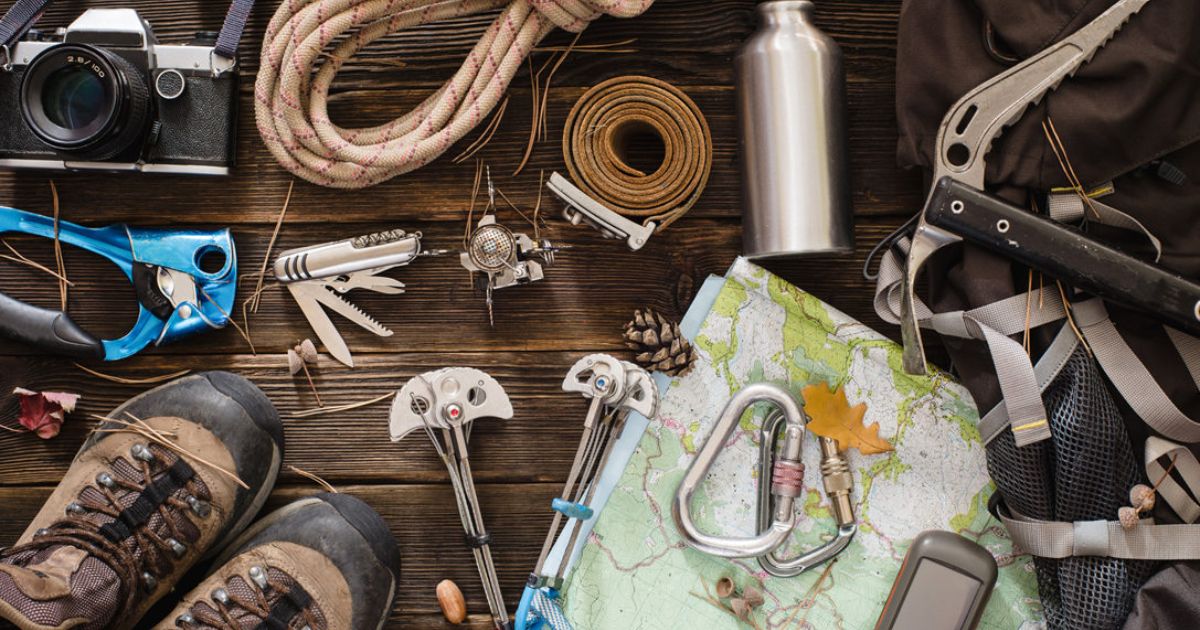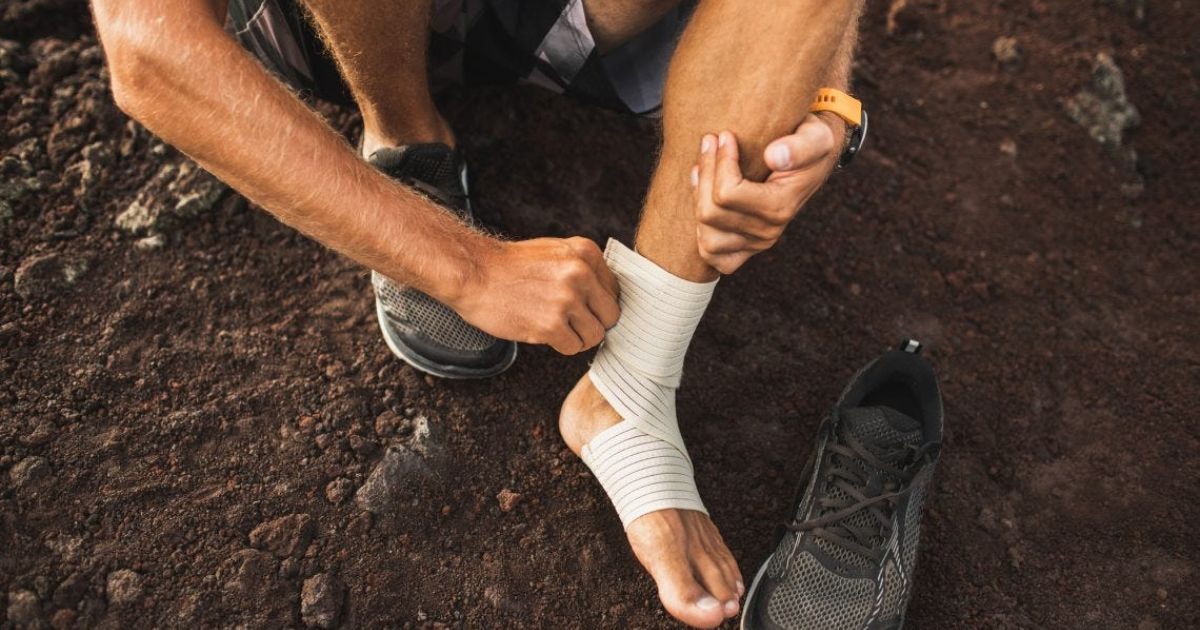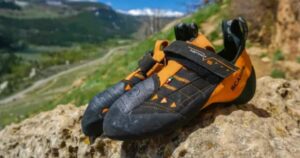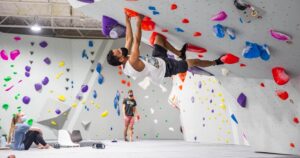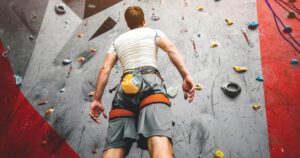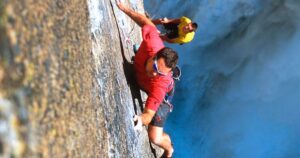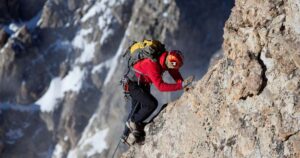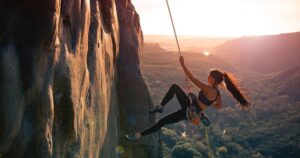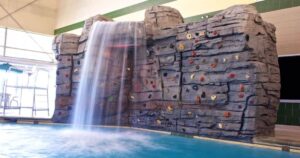Did you know that rock climbing has gained immense popularity in recent years, with over 9.5 million active participants in the United States alone? If you’re looking to join this growing community and improve your climbing skills, you’ve come to the right place. In this article, we will explore the key factors that contribute to becoming a proficient climber, from mastering technique and strength training, to mental strategies and injury prevention. Get ready to take your climbing abilities to new heights.
Key Takeaways
- Proper climbing equipment selection is crucial for safety and performance.
- Developing proper technique through balance training, footwork drills, and efficient movement is essential.
- Strength training targeting specific climbing muscles improves climbing performance.
- Grip strength can be enhanced through specific finger exercises and the use of grip training equipment.
Equipment Essentials
The acquisition of proper gear is crucial for climbers looking to excel in their sport. Climbing shoe selection is one of the most important considerations for climbers, as it directly affects their performance and safety. When choosing climbing shoes, climbers must consider factors such as fit, type of climbing, and personal preference. A snug fit is essential to ensure precise footwork and minimize the risk of slipping.
Additionally, climbers should select shoes that are appropriate for their chosen style of climbing, whether it be bouldering, sport climbing, or trad climbing. In terms of safety gear, climbers should never compromise on essential equipment such as a helmet, harness, and a reliable rope. These items provide protection against potential falls and ensure a safe climbing experience. Belonging to the climbing community means understanding the importance of selecting the right equipment for the task at hand.
Developing Proper Technique
To further enhance climbing skills, climbers must focus on honing their technique, building upon the foundation laid by acquiring the proper gear. Developing proper technique is crucial for climbers to excel in their sport. Here are four essential aspects to consider when working on technique:
- Balance training: Climbing requires exceptional balance and body control. Practicing exercises that challenge your balance, such as standing on one leg or using a balance board, can significantly improve your climbing ability.
- Footwork drills: Foot placement is key to maintaining stability and conserving energy while climbing. Engage in footwork drills that focus on precise foot placement and weight distribution to develop efficient climbing movements.
- Body positioning: Learning how to position your body correctly on the wall is essential for effective climbing. Practice proper body alignment and learn to anticipate and adjust your body position in different climbing situations.
- Efficient movement: Climbing efficiently involves using the least amount of energy while making progress on the wall. Work on fluid and controlled movements, minimizing unnecessary muscle exertion.
Strength Training for Climbers
Strength training is essential for climbers looking to improve their performance and excel in the sport. It focuses on developing the specific muscles and skills required for climbing, such as finger strength and balance. Incorporating a well-rounded strength training routine into your climbing regimen can help you overcome challenging routes and reach new heights.
To effectively train for climbing, it is important to target the muscles that are heavily involved in the sport. This includes the muscles in the fingers, forearms, shoulders, and core. Finger strengthening exercises, such as fingerboard hangs and campus board exercises, can help climbers develop the necessary grip strength for holding onto small holds. Balance training, on the other hand, can improve a climber’s stability and control when navigating uneven surfaces.
Table: Essential Strength Training Exercises for Climbers
| Muscles Targeted | Exercises |
|---|---|
| Fingers | Fingerboard hangs, campus board exercises |
| Forearms | Forearm curls, wrist curls |
| Shoulders | Shoulder press, lateral raises |
| Core | Planks, Russian twists |
| Balance | Single leg squats, slacklining |
Incorporating these exercises into your training routine, along with proper technique and conditioning, can greatly enhance your climbing performance. Remember to always prioritize safety and listen to your body to avoid overexertion and injury.
Tips for Improving Grip Strength
Improving grip strength is crucial for climbers as it directly impacts their ability to hold onto holds and maintain control while climbing. To enhance grip strength, climbers can engage in specific finger exercises that target the muscles and tendons in the hands and fingers. Additionally, utilizing specialized equipment such as grip trainers and fingerboards can provide climbers with progressive resistance training to further develop their grip strength.
Finger Exercises for Grip
One effective way to enhance grip strength is by incorporating finger exercises into your climbing routine. Improving finger strength is crucial for climbers as it allows for better control and stability while navigating challenging routes. Here are four finger strength exercises that can help climbers develop a stronger grip:
- Hang board Training: Hang boards are specifically designed for finger strength exercises. They provide various-sized edges and pockets that challenge climbers to work on their grip strength and endurance.
- Finger Extensions: Place a rubber band around your fingertips and extend your fingers against the resistance. This exercise targets the extensor muscles, which are often neglected but play a vital role in maintaining balance and preventing injuries.
- Finger Rolls: Use a grip trainer or a ball and roll it around in your hand, focusing on activating different finger muscles. This exercise helps improve finger dexterity and grip control.
- Pinch Grips: Hold two weighted plates or pinch blocks between your thumb and fingers, focusing on squeezing them together. This exercise targets the pinch grip strength, which is essential for gripping thin holds and edges.
Incorporating these finger strength exercises into your hand grip training techniques will gradually improve your grip strength, allowing you to tackle more challenging climbs with confidence.
Equipment for Grip Training
To enhance grip strength and improve climbing performance, climbers can utilize specific equipment designed for grip training. Grip training aids are essential tools that target the muscles in the hands and forearms, helping climbers develop the necessary strength and endurance for tackling challenging routes. One popular piece of equipment is the grip strengthener, which comes in various resistance levels to accommodate different skill levels.
Hand grippers are another effective tool that focuses on strengthening the fingers and the overall grip. Additionally, climbers can use fingerboards, also known as hang boards, to perform various hand-strengthening exercises such as finger hangs and pull-ups. These tools provide climbers with the opportunity to train their grip outside of climbing sessions, allowing for targeted and progressive improvement in grip strength. By incorporating these grip training aids into their training routine, climbers can enhance their climbing ability and conquer more difficult routes.
Transition: Now that we have explored the equipment for grip training, let’s dive into the mental strategies for climbing success.
Mental Strategies for Climbing Success
Developing a strong mindset is essential for achieving success in climbing. To excel in this challenging sport, climbers need to develop focus and learn how to visualize success. Here are four mental strategies that can help climbers improve their performance:
- Mindfulness: Cultivating a present-moment awareness helps climbers stay focused and connected to their movements. By being fully engaged in the climb, distractions are minimized, and performance is maximized.
- Positive self-talk: The language we use internally can greatly impact our climbing abilities. By replacing negative thoughts with positive and encouraging self-talk, climbers can boost their confidence and overcome obstacles with a determined mindset.
- Goal-setting: Setting clear and achievable goals provides climbers with a sense of direction and purpose. By breaking down larger goals into smaller, manageable steps, climbers can track progress and stay motivated along their climbing journey.
- Visualization: Mental rehearsal is a powerful tool for climbers. By vividly imagining successful climbs, visualizing movements, and anticipating challenges, climbers can better prepare themselves for the physical demands of the climb.
Mastering Challenging Routes
Mastering challenging routes in climbing involves overcoming fear and doubt while also understanding the balance between technique and strength. Fear and doubt can hinder a climber’s performance, so it is essential to develop mental strategies to overcome these obstacles.
Additionally, technique plays a crucial role in successfully navigating difficult routes, as it allows climbers to use their bodies efficiently and conserve energy. However, strength is also important, as it provides the physical power needed to execute challenging moves. By combining mental resilience, technical skill, and physical strength, climbers can improve their ability to conquer challenging routes.
Overcoming Fear and Doubt
Overcoming fear and doubt while climbing challenging routes requires a strategic approach and consistent practice. Building confidence and mental preparation are crucial elements in tackling these obstacles. Here are four key strategies to help climbers overcome fear and doubt:
- Visualization: Before attempting a challenging route, visualize yourself successfully navigating each move. This mental rehearsal can help build confidence and alleviate anxiety.
- Controlled Exposure: Gradually expose yourself to increasingly difficult routes, starting with ones slightly outside your comfort zone. This progressive approach allows you to build confidence and develop the necessary skills for more challenging climbs.
- Positive Self-Talk: Replace negative thoughts with positive affirmations. Remind yourself of past successes and focus on your abilities rather than your doubts. This positive self-talk can boost confidence and help overcome fear.
- Breathing Techniques: Practice controlled breathing to calm your mind and body during challenging climbs. Deep breaths can help reduce anxiety and enhance focus, allowing you to maintain composure and make clearer decisions.
Technique Vs. Strength
How can climbers effectively navigate challenging routes: by prioritizing technique or strength? This is a common question among climbers looking to improve their performance on difficult climbs. The answer lies in finding the right balance between technique and strength training methods. While having a strong physical foundation is important, it is equally crucial to develop proper climbing techniques to efficiently tackle challenging routes.
To help you understand the importance of both technique and strength, let’s break it down in the following table:
| Technique | Strength |
|---|---|
| Focuses on efficient movement and body positioning | Enhances power and endurance |
| Emphasizes balance, footwork, and body awareness | Builds muscle strength and improves grip |
| Helps climbers conserve energy and prevent fatigue | Enables climbers to tackle difficult holds and moves |
| Reduces the risk of injury by promoting proper form | Supports injury prevention through muscular stability |
| Allows climbers to navigate tricky sections with finesse | Assists in overcoming physical obstacles |
Injury Prevention and Recovery Strategies
One key strategy for injury prevention and recovery in climbing is implementing a comprehensive set of exercises and routines. These exercises and routines are designed to strengthen the muscles used in climbing, improve flexibility, and enhance overall body awareness and control. Here are four essential components of an effective injury prevention and recovery program for climbers:
- Warm-up exercises: Prior to climbing, it is important to perform dynamic stretches and exercises that target the specific muscles used in climbing, such as the forearms, shoulders, and core. This helps to increase blood flow, warm up the muscles, and prepare the body for the physical demands of climbing.
- Strength training: Incorporating resistance training exercises, such as pull-ups, push-ups, and squats, can help improve overall strength and stability, reducing the risk of injury during climbing.
- Flexibility training: Stretching exercises that focus on the muscles used in climbing, such as the hip flexors, hamstrings, and calves, can help improve flexibility and range of motion, reducing the risk of muscle strains and tears.
- Rest and recovery: Allowing adequate time for rest and recovery is crucial for injury prevention. This includes taking regular rest days, getting enough sleep, and incorporating active recovery techniques, such as foam rolling and gentle stretching, to promote muscle repair and prevent overuse injuries.
Frequently Asked Questions
How Can I Overcome Fear of Heights While Climbing?
Overcoming the fear of heights while climbing requires mental preparation and a systematic approach to gradually expose oneself to higher altitudes. Developing trust in equipment, practicing visualization techniques, and seeking guidance from experienced climbers can aid in conquering this fear.
What Are Some Common Mistakes Beginners Make When Climbing?
Common mistakes beginners make when climbing include improper use of safety equipment, lack of proper technique, not warming up adequately, and overestimating their abilities. It is important to prioritize safety precautions to avoid accidents and injuries.
How Often Should I Rest Between Climbing Sessions?
The resting period between climbing sessions is a crucial aspect of training. Adequate rest allows for muscle recovery, injury prevention, and improved performance. Understanding the benefits of taking breaks can greatly contribute to one’s progress in climbing.
What Are Some Recommended Warm-Up Exercises Before Climbing?
Dynamic stretches and finger strength training are essential warm-up exercises before climbing. Dynamic stretching helps increase flexibility and blood flow, while finger strength training improves grip strength and endurance. These exercises are vital for climbers to perform at their best.
Are There Any Specific Diets or Nutritional Recommendations for Climbers?
Climber’s nutrition plays a crucial role in optimizing climbing performance. Proper hydration, consuming nutrient-dense foods, and incorporating dietary supplements can enhance strength, endurance, and recovery. Consulting with a sports nutritionist can provide tailored recommendations.
Conclusion
In conclusion, becoming proficient in climbing requires a combination of equipment knowledge, technique development, strength training, grip improvement, mental strategies, mastering challenging routes, and injury prevention and recovery strategies. Like a skilled painter creating a masterpiece with every brushstroke, climbers must meticulously refine their skills and push their limits to reach new heights. With dedication and perseverance, climbers can transform themselves into agile and tenacious climbers, conquering obstacles with grace and precision. So, grab your gear, embrace the challenge, and let your climbing journey begin.

